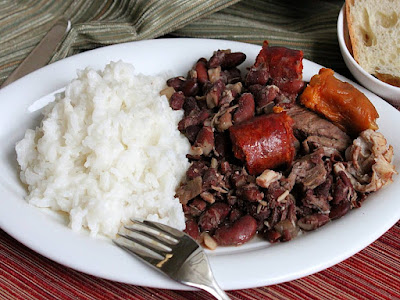I love eating, and eating good food is always something truly special. Coming across a dish that makes you salivate, that you can smell (even if it's just a photo, it is that well prepared and photographed) is one of life's great pleasures, way up there with a good wine, good Scotch, an excellent beer or a cup of coffee that makes you feel the day can throw anything at you, you are that psyched up.
Although my time on the Azorean island of São Miguel was regrettably not quite two years long, I discovered some truly amazing dishes and foods that will always tingle my palate, even in memory.
The following represent what I came to savour while on the island. Note that the images are from the web and copyright resides with the original creators.
 |
Walk into even the smallest restaurant on the island, and you will be greeted by a saucer or side plate on your table, and on it a small portion of queijo fresco, or "fresh cheese". These goats cheeses are home made on the day and absolutely amazing. They are normally served with pimenta moida (a salty, Portuguese pickled pepper sauce, also home made). Enjoying one's cheese with the selection of breads on offer on your table (in my days at no extra cost) while waiting for your meal to be served is one of the true Azorean pleasures.
***
This one is very special indeed! Known as cozidos das Furnas, it is a stew prepared in a very unusual way, and a speciality of the town of Furnas on São Miguel. A large pot is filled with vegetables, typically carrots, sweet potatoes, cabbage, and yam, as well as the meats: chouriço, (a spicy Portuguese sausage), chicken, beef brisket, pigs’ ears, ham ends, pork belly, and morcela, a cinnamon-scented blood sausage. The pot is then placed in a canvas or hessian bag and lowered into one of the many fumaroles (volcanic steam vents) on the north-western shore of the caldera lake of Furnas. A wooden lid is placed over the fumarole, soil is heaped on top of that, and the whole shebang is left for as long as seven hours, but usually not less than five or six. When served, the dish still smells of the lingering traces of the sulphur from the fumarole, but the taste is something out of this world! The vegetables are soft, but not soggy, and the meats melt-in-the-mouth tender. I tasted cozido for the first time during a stay in the Hotel Terra Nostra in the town, but after that our favourite restaurant in Furnas was the Miroma, where cozido das Furnas is a speciality. My tour groups usually enjoyed theirs at the Hotel Terra Nostra, though. *** |
 |
Feijoada is another dish popular in most Portuguese-speaking countries, from the mainland to Brazil, from the Cape Verde islands to Goa. Made with beans (feijão means "beans") and meat, usually pork and choriço, but sometimes with beef, chicken or morcela (blood sausage) as well. The type of beans used also vary from region to region, with red kidney or white beans most common outside Brazil, where they prefer black beans. Like all the other dishes mentioned in this blog, this is also an unforgettably delicious culinary delight. *** |
 |
This one is definitely not for the squeamish! I first tasted cracas (barnacles) on the terrace of the Estrela do Mar restaurant overlooking the fishing harbour of Vila Franca do Campo. The barnacles are boiled in sea water, with any seaweed still attached, and served as is. In my case we were given forks with one tine bent to dig out the meat from the shell of the barnacle. It was delicious, if rather expensive-- a serving for two those days cost the equivalent of a bottle Of Johnny Walker Red! |
 |
Bolos lêvedos are another sweet bread from the island. They are similar to muffins, but slightly firmer, and without any additions. More yeast than normal is used to make them, and they are most often fried in a dry frying pan at very low heat. The light dusting of flour on each side is also typical. In my time on the island the best examples came from a bakery in Furnas. *** |
 |
Last on our list today, but by no stretch of the imagination least, is the staple fish for all Portuguese, bacalhau. The Atlantic cod, Gadus morhoa, is usually stored and sold salted and is probably the most Portuguese of all dishes, having been part of the cuisine of the nation since the 15th century and the beginning of the Portuguese voyages of exploration that lead the tiny nation to establish colonies as far afield as South America and the Indian subcontinent. The dish I grew to like most, was bacalhau com natas, or cod with cream. We often made this at home and always enjoyed it tremendously. I hope you enjoyed this little culinary tour of a place I grew to love very dearly. |













Comments
Post a Comment